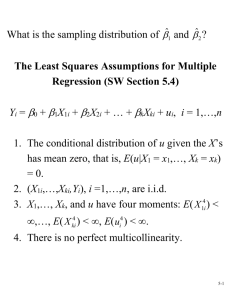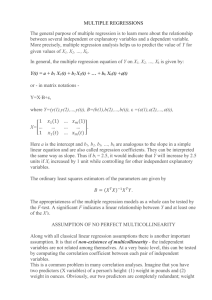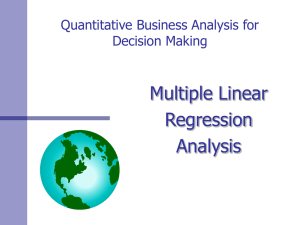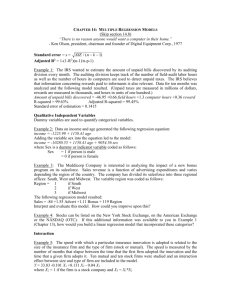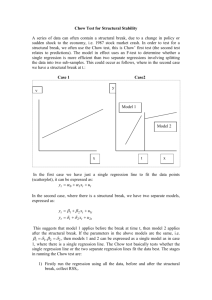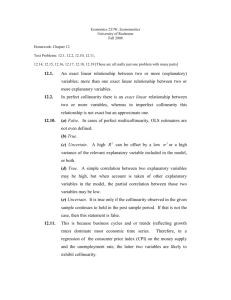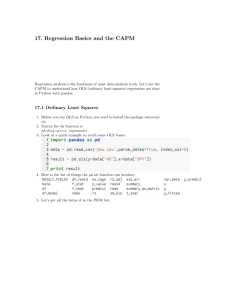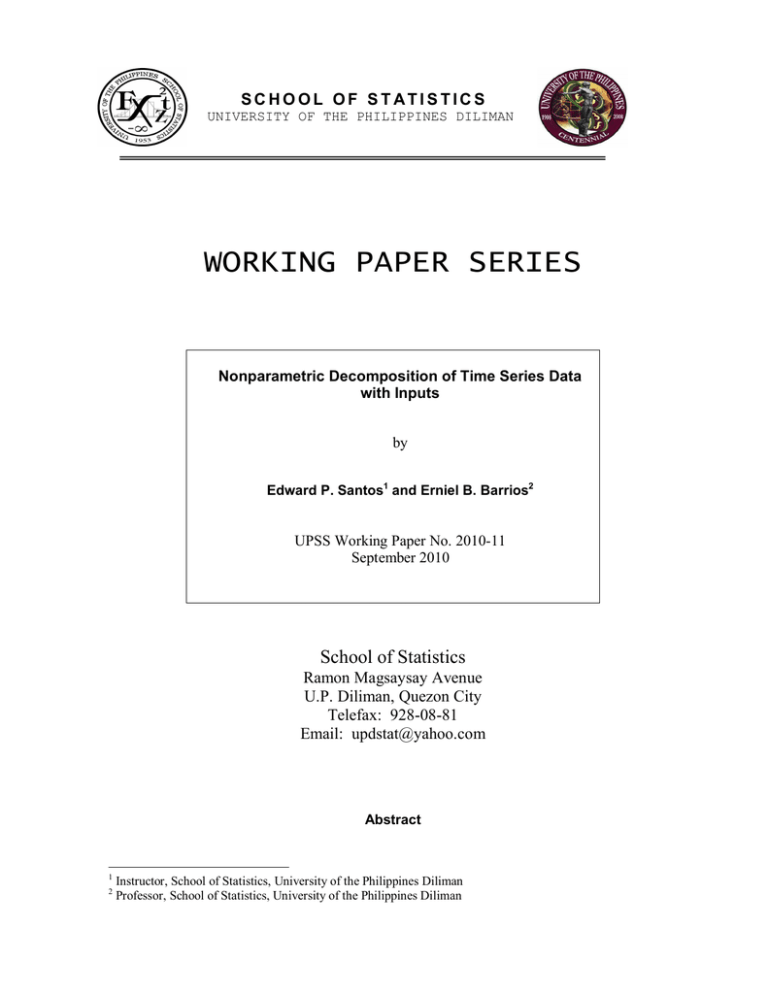
SCHOOL OF STATISTICS
UNIVERSITY OF THE PHILIPPINES DILIMAN
WORKING PAPER SERIES
Nonparametric Decomposition of Time Series Data
with Inputs
by
Edward P. Santos1 and Erniel B. Barrios2
UPSS Working Paper No. 2010-11
September 2010
School of Statistics
Ramon Magsaysay Avenue
U.P. Diliman, Quezon City
Telefax: 928-08-81
Email: updstat@yahoo.com
Abstract
1
2
Instructor, School of Statistics, University of the Philippines Diliman
Professor, School of Statistics, University of the Philippines Diliman
The backfitting algorithm commonly used in estimating additive models is
used to decompose the component shares explained by a set of predictors on
a dependent variable in the presence of linear dependencies (multicollinearity)
among the predictors. Multicollinearity of independent variables affects the
consistency and efficiency of ordinary least squares estimates of the
parameters. We propose an estimation procedure that address this problem
by estimating shares of each predictor one at a time, the sequence depends
on the initial guess of the relative importance of the variables in the model.
Simulated data show that backfitting the ordinary least squares procedure and
additive smoothing splines are comparable and superior over the ordinary
least squares in estimating share of the contribution of the different predictors
to the dependent variable. The superiority of the predictive ability of the
method is also more apparent as multicollinearity worsens. The method is
used in modeling sales data with predictors including marketing activation
indicators, competition measures, distribution indicators, economic and
weather indicators. The sales data (time series) that is characterized by
severe multicollinearity and inadequate linear fit illustrates the advantage of
additive model estimated through backfitting with spline smoother over
ordinary least squares and the backfitted linear smoother in terms of
predictive ability (MAPE) and interpretability of the estimated shares of the
predictors to the dependent variable.
Keywords: multicollinearity,
nonparametric regression
ordinary
least
Squares,
additive
Models,
backfitting,
1. Introduction
The utility of a model depends on how realistic it captures the dynamics in which the
independent variables influence the dependent variable. It is also important that the
predictors whom the modeler has direct control of are included so that it can be used in
optimal control. In business, it is important for a model to capture various internal factors like
indicators of marketing efforts and external factors like economic indicators, such model can
be used in determining the optimal level of internal factors conditional on the levels of
external factors. This simulation can be facilitated with a decomposition of how much each
of the internal and external factors contributes to the magnitude of the dependent variable is
available.
In modeling of continuous dependent variables (e.g., sales), the least squares procedure is
commonly used in the construction of a mathematical in which the dependent variables
interacts with the predictors. Ordinary least squares theory (OLS) provides estimates of the
regression coefficients for each predictor X i in the model Y X by minimizing the error
sum of squares Y X
2
. Subsequently, the fitted model can assist in the computation of
the relative share of each variable to the magnitude of the dependent variable. The OLS
estimate of the regression parameter is given by ˆ X X X Y . This requires the
1
inversion of the inner product of the design matrix X, whose stability relies on whether the
design matrix is orthogonal or not. As the design matrix becomes non-orthogonal, ill1
conditioning on X X is magnified resulting to excessively large elements of X X . OLS
suffers severely with increased levels of association and departure from orthogonality of the
predictors. The problem of multicollinearity distorts the size and direction of the model
parameters and affects prediction as well. Multicollinearity occurs very often in business
models and other applications due to the inherent association among natural predictors of
the dependent variable. Having two predictors with values that move together would
automatically result in a near-linear dependency, even if it is only due to the common effect
of a latent variable (that may or may not be included in the set of predictors). Estimation of
the effects and component shares of these regressors to the dependent variable becomes
complicated.
The simplest and most commonly used remedy for multicollinearity is variable deletion. The
modeler first identifies the source of the linear dependency and deletes (one or more)
independent variables to remove the association, alleviating the possible non-invertibility of
X X . However, this forfeits the presence of a modeling framework that ought to explain the
theoretical basis of certain relationships and assumes that the effects of the excluded
predictors are negligible.
Ridge-type estimators and principal component regression (PCR) are also used as a
modeling strategy when X X becomes ill-conditioned. Ridge regression adjusts X X into
X X k I (with k a parameters and I an identity matrix) to avoid perfect linear
dependencies of the columns of X X . This technique however shows mixed results against
OLS under different scenarios, partly due to the method of selection of k . PCR meanwhile
produces indices that are hard to interpret and are far away in form from the theoretical
expectations on the component estimates as they are given in the original model. Also, PCR
doesn’t provide leeway for better estimation of predictor-shares that are deemed to be more
important than other predictors. Management and policy focus are generally not equally
divided among all the determinants, as some prognostic factors are often given more weight
in decision making than others. Both ridge regression and principal component regression
produces estimates that are biased. The amount of bias in ridge regression is proportional
to k , unlike in principal component regression, where the bias is dependent on the last few
components excluded as regressors.
Suppose that sales as the response variable and exogenous variables (maybe internally
controllable or not) are available. An ideal marketing mix is desirable, i.e., which among
those controllable factors like availability of the product, exposure time on television, etc.,
should be prioritized. This will require estimation of the contribution share of the different
determinants to aggregate sales.
We propose to use a class of additive models (Hastie and Tibshirani, 1990) to produce
estimates of the components explained by a set of predictor variables on a single continuous
response with muticollinearity present among the independent variables. In particular, the
backfitting algorithm as a common method for estimating additive models (Hastie and
Tibshirani, 1990) is used in estimating the component shares of the different predictors.
When the effects of each predictor are analyzed and set aside one-at-a-time, the problem of
attribution of common shares by two or more predictors can be avoided. The decomposition
method for the effects incorporates the option of using a flexible nonparametric form for the
component effects, increasing the optimality of estimation. This is true since forecasts are not
bound by the restrictive form of the traditional linear model. It is also possible to incorporate
the relative importance of the regressors to each other in explaining the response Y into the
procedure through their priority of entry into the backfitting algorithm. In this manner,
estimated shares of indices that are deemed to be of more importance in policy-making can
be obtained with more accuracy and confidence relative to other predictors of Y . In the
procedure, the possible constraint of additivity of effects can be easily avoided by a flexible
form (nonparametric) of each component explained by the X j ' s ; i.e., the function f j that
links the j th regressor to Y .
2. Some Modeling Issues and Strategies
The presence of linear relationships among predictors of a dependent variable masks the
nature of the regression coefficients in OLS, often, parameter estimates contradict theory.
The repressive proportional-to- form of the components binds the gains brought about by
assuming a linear model which is supposed to induce simplicity in the interpretation of share
estimates. The assumption of additivity of effects would only be a small price to pay for poor
model specification if the component shares of the independent variables are estimated as
close as possible to their true values. Lauridsen and Mur (2006) summarizes the
consequences of multicollinearity on forecasting and inference (unpredictable estimation
results, high standard errors, coefficients in the incorrect direction, and unfeasible sizes of
parameters). Also as cited in Lauridsen and Mur (2006), several works illustrate the
asymmetry of multicollinearity’s effects: Chatterjee and Hadi (1988) and Belsley et.al. (1980)
show that sharp linear dependencies affect the ˆ 's in OLS but not necessarily the predicted
values and residuals. There are also instances where the number of regressors and the
degree of multicollinearity itself directly affect the estimates, e.g., Farrell (2002) observed that
estimates reacted directly to the number of predictors and the level of linear dependencies.
There are many solutions proposed in the literature to address the multicollinearity problem.
Ridge regression is among the early solutions as proposed by Hoerl and Kennard (1970),
1
where the OLS estimate is modified as ˆ k X X k I X Y where k 0 . While the
estimator incurs bias, the gain is in terms of mitigating the ill-conditioning of X’X that can lead
to unstable OLS estimates. Several modifications of ridge regression were proposed, e.g.,
Yalian and Hu (2008) introduced a random component into the ridge specification leading to
a stochastic mixed ridge estimator. The mixed specification is advantageous for large values
of the ridge parameter, but the reverse happens as k decreases. Similarly, Lipovetsky
(2006) introduced a revised version of a two-parameter ridge model and defined the net
effect of a predictor X j to Y as j X Y j and showed that these quantities can be
interpreted well in the ridge model unlike in OLS. The net effect quantity measures the share
2
of a regressor X i on the coefficient of determination or total variability explained ( R ).
Defining the component share or effect in this manner though shows that OLS generally will
have better forecasting power, and translates negative component effects as being
uninterpretable (Lipovetsky, 2006). This indicated the need for another quantity to summarize
the effects of a regressor that incorporates the model parameter j at the same time.
Baye and Parker (1984) meanwhile developed the division of r k of estimators that include
OLS, ridge regression, and PCR as special cases and compared their respective
performances by their MSE’s theoretically. The functional similarities in form and
performance of ridge regression and PCR are also noted by Lipovetsky and Conklin (2001).
Later, Sarkar (2006) derived the theoretical bases for the increased efficiency of this general
type of estimator over OLS using a mean squared error matrix. However, these theoretical
results have yet to be validated in practice.
Kosfeld and Lauridsen (2008) compared the performance of factor analysis regression
(FAR) and PCR relative to OLS in the presence of variables with varying strengths of
multicollinearity by Monte Carlo simulations. FAR and PCR provided favorable estimates at
strong and extreme multicollinearity, with FAR superior at moderate levels. However, this is
true only for cases where the effects of the independent variables are near identical to each
other. Furthermore, FAR and PCR variations tend to equalize the effect of predictors that
belong to the same factor group (Kosfeld and Lauridsen, 2008), and doesn’t distinguish
between component shares with high specificity. Similarly, in analyzing the use of sparse
principal components in nonstationary time series, Lansangan and Barrios (2009) presented
this same equalizing effect of PC regression on the component loadings of different
variables. This is disadvantageous in cases where some indices that affect the response
have distinctively large contributions to Y in the true decomposition, notwithstanding the
importance of a predictor relative to the other independent variables in the model. These
varied results show that multicollinearity cannot be solved extensively through various
methodologies.
Additive
models
are
extensions
of
the
classical
linear
model
specification
Y 0 1 X 1 L p X p and are previously viewed as preliminary and descriptive
tools. Hastie and Tibshirani (1990) argued that the concept of additive models serving as an
initial procedure to locate the patterns and behavior of the predictors relative to the response,
suggesting a possible parametric form for which to model Y at a later stage. An additive
p
model can be specified as Y
f X ,
j
j
where the individual functions
fj
j 1
representing the link between the j th predictor and Y . Note that each f j can be distinct
from the others, with each regressor linked to the response in a different way. This removes
the constraint present in the linear model, where each X j component to be decomposed is
proportional to j X j . Also, the representative functions do not have to be specified fully and
can be nonparametric. This adds flexibility in estimating the relationship between Y and X's .
A proper and effective design for the f j 's would bring out an increased gain in estimation of
the decomposed predictor effects and would more than compensate for the additive
approximation to the true regression surface f X 1 , X 2 ,L , X p .
To estimate and additive model, backfitting is commonly used. The Backfitting Algorithm’s
iterative procedure proceeds as follows (Hastie and Tibshirani, 1990):
i
Initialize: average yi , f j f j0 , j 1, L , p
ii Cycle: j 1,
L , p, 1, L , p, L
f j S j y k j fk | x
iii
(1)
Continue ii until the individual functions stabilize.
where the f j 's are the true functions that represent the component or share that is being
explained by the j th regressor. The individual estimators S j are smoothers used to quantify
the effect of the j th regressor. Note that in the representation, S j can have any functional
form, e.g., X j j in OLS, or a histogram smoother in nonparametric regression. Also, the
exact form of the S j 's need not be specified (possibility nonparametric). The class of cubic
smoothing splines for the S j 's provide solution to the penalized least squares (Hastie and
Tibshirani, 1990) criterion:
n
y f x
i
i 1
i
2
b
2
f '' t dt .
(2)
a
Then the function f that minimizes this criteria is the cubic spline estimate of the true link
between Y and X i . The solution f is a balance between the smoothness of the
estimates and model fit. The choice of is determined via the generalized cross validation
criterion (GCV), (Hastie and Tibshirani, 1990). The general form of the GCV is
2
1 n y f ( xi )
GCV ( ) i
.
n i 1 1 tr ( S ) n
(3)
This entails creating a jackknifed fit at each value xi of X and computing for prediction and
squared errors, leaving out one observation at a time (Hastie and Tibshirani, 1990). f xi
represents the smooth estimate at xi with S representing the smoothing matrix (Hastie and
Tibshirani, 1990). The common choices for the spline knot locations are the data points
xi , yi themselves. For backfitting OLS, the partial residuals are modeled at each iteration
using X j as the lone independent variable by least squares. This is different from the
classical OLS procedure since the components of each variable are not estimated
simultaneously, but iteratively using the partial residuals (excluding the effect of X j ). In the
backfitting algorithm, step iii rarely presents cases of non-convergence of the effects fˆ j
(Hastie and Tibshirani, 1990).
3. Decomposition Method
Given a regression model
Y X
(4)
Let X X 1 , X 2 and 1 , 2 . If X 2 is ignored and Y is regressed on X 1 , the OLS
estimate of 1 is biased if X 1 X 2 0 . This implies that our understanding on the
contribution of each predictor is contaminated once they possess some overlaps on the
proportion of Y they ought to explain. The contribution of the predictors X 1 , X 2 , , X p on
the dependent variable Y is an important information that help facilitate optimal control and
decision-making. Suppose Y is sales and X 1 is expenditure on television advertisements,
while X 2 is expenditure on mall activation. These indicators are usually time series
realization of a stochastic process. A business strategist would be interested to know which
strategy sales is most sensitive to. This will be an important input in formulating an optimum
marketing mix, i.e., prioritization between television advertisements versus mall activation.
The standardized estimates of the regression parameters suffice to produce the information
required in the formulation of the marketing mix. In many business and economic settings
where indicators are monitored over time, there is a tendency for these indicators to drift
simultaneously as they progress over time, see for example, Lansangan and Barrios (2009).
In this case, multicollinearity problem yields undesirable effects on the least squares
estimates, e.g., unstable or inefficient estimates of the regression coefficients.
Consequently, the estimated share of each predictor is also affected.
Suppose that an outcome indicator yt is to be decomposed according to the share of the
different predictors x1t , x2 t ,..., x pt . We would like to decompose yt according to the additive
model
yt f1 x1t f 2 x2t ... f p x pt t
The nonparametric nature of
(5)
f will mitigate the ill-condition that a linear model usually
j
suffer as a consequence of linear dependencies among the dependent variables. The
methodology facilitates the use of a class of additive models (Hastie and Tibshirani, 1990) in
decomposing the effects of predictors (possibly collinear) on yt . The steps in partitioning the
components are as follows:
1. Determine the priority of inclusion of the independent variables for entry to the
backfitting algorithm. Pairwise correlation between the dependent variable and
the predictors can be used (predictor with higher correlation with the dependent
variable comes first). It is also possible to consider the degree of importance of
the variable in optimally controlling for the variation of the dependent variable,
e.g., marketing expenditure is more important than distribution of competition,
thus, it goes first in the iteration of the backfitting algorithm.
2. Estimate the component explained by X j
f in the additive model (5) based on
j
the smoother S j , i.e., determine fˆj . In each iteration of the backfitting algorithm,
S j smoothes the partial residuals Y ̂ k j fˆk , excluding the variable X j in
the computation.
3. Continue cycling through steps (2) and (3) of the algorithm until the estimates of
the shares stabilize. Convergence of estimates is assumed if the value of fˆj do
not change more than % from the last iteration.
4. Compute for the proportion of estimated share of each predictor on the dependent
variable. The estimated share of X j is defined as:
ˆ j x ji
Yi
i 1
Estimated ShareX j
n
n
(6)
from the linear model in (4), or
fˆ ji
i 1
i
Estimated ShareX j
n
n
Y
(6a)
from the nonparametric model in (5).
The definition of shares above is advantageous since the component explained by a variable
is the average of the j th additive effect over all observations. It incorporates both the range
of X j and the parameter j (if the true model is linear). It is interpretable regardless of the
size and magnitude of the independent variables as well, even under multicollinearity.
Casals, et al (2010), decomposed a state-space model into the contributions of the different
inputs. The result is used in estimating the return on investments (ROI) of advertising.
4. Simulation Study
A simulation study is conducted under the assumption that there are groups of correlated
indices that affect the response variable in the model. The basic specification has the form
Yi 0 1 X 1i 2 X 2i 3 X 3i 4 X 4i 5 X 5i k i
(7)
where
X 1 , X 2 , X 3 ~ Uniforma, b
and
X 4i 1' X 1i k1 1i , 1 ~ N 1 , 12
''
1
''
2
X 5i X 2 i X 3i k 2 2 i , 2 ~ N 2 ,
(8)
2
2
(9)
There are three primary predictor variables are considered: X 1 , X 2 , and X 3 . The pairwise
correlations among X 1 , X 2 , and X 3 are minimized (smaller than 0.3) to simulate a set of
distinct and weakly dependent regressors. Two groups of multicollinearity are induced, one in
X 4 and the other in X 5 . X 4 is assumed to depend on X 1 alone while X 5 depends on X 2
and X 3 . This captures events where the dependencies between the independent variables
are present over several groups. Without loss of generality, the error terms 1 , 2 , and
are assumed to have a N 0,1 distribution.
k is used to control model fit of (7) while
k1 , and k 2 are used to control the extent of multicollinearity among the predictors. Table 1
summarizes the simulation parameters for both the cross-section and well as time series data.
Table 1. Simulation Parameters
Cross Sectional Data
K
k1
k2
size/length of sample
1 (good model fit)
10000 (moderately good
model fit)
1000000(poor model fit)
1 (strong multicollinearity)
100 (moderate
multicollinearity)
500(weak/no
multicollinearity)
1 (strong multicollinearity)
100 (moderate
multicollinearity)
500(weak/no
multicollinearity)
20, 100
Time Series Data
1 (good model fit)
1000 (moderately
good model fit)
1000000 (poor model
fit)
1 (strong
multicollinearity)
100 (moderate
multicollinearity)
500(weak/no
multicollinearity)
1 (strong
multicollinearity)
100 (moderate
multicollinearity)
500(weak/no
multicollinearity)
40, 400
The range of X 1 , X 2 , and X 3 , they are set to take values from -100 to 100. Different
parameters are controlled to assess the performance of the additive modeling procedure. Of
extreme importance are k1 and k2 respectively. These control the level of multicollinearity
present (1 for strong, 100 for moderately strong, and 500 for weak multicollinearity), as they
indicate the size of the error terms in the dependencies of X 4 on X 1 and of X 5 on X 2 and
X 3 . It is also of interest to assess the performance of additive modeling and backfitting under
small and large sample sizes (20/40 as small/short and 100/200 as large/long, respectively).
In addition, the inclusion of a constant k as a multiplier to the model error measures model fit
(also, possible departures from additivity).
In the context of time series data, the model in (7) is still maintained, but this time with the
behavior of X 1 , X 2 , and X 3 governed by an AR(1) process where
1 B X t at
(10)
and at ~ N 0,1 with B as the backshift lag operator (Wei, 2006). The value of influences
stationarity of the series X t , i.e., (10) is stationary if 1 . In the simulation study, is
assigned the value of 0.5. Stationarity is targeted in the simulation to control the present
dependencies in the model to appear only through X 4 and X 5 , since nonstationary
processes exhibit joint movement, see Lansangan and Barrios (2009). The empirical
behavior and summary values of the estimated components and percent differences are
analyzed and compared between those estimated using ordinary least squares and the
proposed additive modeling scheme.
The data-generating model in (7) is simulated from
Yi 12 20 X 1i 3 X 2i 14 X 3i 17 X 4i 10 X 5i k i
(11)
with X 4 i 9 X 1i k11i and X 5 i 4 X 2i 6 X 3i k 2 2i . The values reported are averages over
several cases and scenarios or averaged over the respective replicate datasets. The
performance of least squares regression (OLS), backfitted OLS (BF), and the nonparametric
smoothing spline additive model (SS) are assessed by the percentage differences of their
estimated component shares from the true component shares. These are examined both
when the independent variables are classified as one of the uncorrelated regressors ( X 1 ,
X 2 , and X 3 ) or in the correlated set ( X 4 and X 5 ) or with respect to the priority of entry of
the independent variables into the model measured by the size of their true shares on Y
( share X j ). When analyzing accuracy that are compiled according to the importance of the
predictors X 1 to X 5 , it is possible for the independent variables to change priorities
depending on the case replicate for that specific scenario.
Note that due to the presence of multicollinearity, the estimated shares of the predictors
observably are underestimates of their true values in general with negative component
shares. This is due to the bias induced during estimation since the regressors are nonorthogonal.
5. Results and Discussions
The percentage differences of the estimated shares using OLS, BF, and SS are shown on
Table 2 as averaged over all cross-sectional data by priorities of the estimation of shares of
the independent variables. Considering that the data generating model is linear in form, the
backfitting procedure using the parametric form of least squares as a smoother produces
estimated shares that are closer to their true values for the first three most important
predictors of Y . However, OLS yields closer share estimates for the fourth priority variable.
In this situation though, the nonparametric SS performs at par with OLS (44.36% difference).
On the last priority variable however, BF tremendously outperforms OLS and SS with a share
percent difference of -308.15. This is more than a threefold increase in accuracy compared
to the two other estimators.
Given that the true model is linear, backfitting indeed produced accurate estimates of
component shares of the different predictors, the more accurate are those of shares
estimated ahead in the iterative process.
Table 2. Average Share Size Differences from the True Share Values by Priority of X
entering the Model (Cross Sectional Data)
Priority in Model Entry
First
Second
Third
Fourth
Fifth
Method
OLS
BF
SS
-149.87 -101.68
-158.24
-165.81
-98.93
-167.65
-155.38
-97.77
-152.15
41.26 -104.38
-44.36
-1900.69 -308.15 -1051.52
Table 3 summarizes the difference between estimated shares and the true share values for
time series data with AR(1) regressors. Again, because of the linear form of the data
generating model, backfitted linear smoothers yield estimates of shares that are closer to the
true values. The additive modeling procedure performs (approximately) at par with OLS in
share estimation.
Table 3. Average Share Size Differences from the True Share Values by Priority of X
entering the Model (Time Series Data)
Priority in Model Entry
First
Second
Third
Fourth
Fifth
Method
OLS
BF
SS
-137.58 -115.19
-133.89
-119.89 -114.46
-128.12
278.03
55.87
252.20
103.77
47.70
205.83
-828.96 -627.62 -1598.71
5.1 Effect of Linear Dependencies of the Regressors
Table 4 summarizes the average percent difference of the share estimators according to the
category of the predictors (set of uncorrelated, set of multicollinear independent variables).
For the group of uncorrelated regressors, BF produces share estimates that are closer to
their true values for X 1 , X 2 , and X 3 . BF estimates the share of X 2 most optimally with a
fifteen-fold increase in accuracy in the cross-section case. SS performs relatively at par with
OLS, with a more accurate shares for X 2 and X 3 and a worse component for X 1 . In the
correlated set, OLS outperforms both BF and SS in the share of X 4 . However, BF produces
slightly better shares than OLS in X 5 .
Table 4. Average Share Size Differences from the True Share Values by Nature of X at
Moderate and Weak levels of Multicollinearity (Cross-Sectional Data)
Nature of Predictors
Predictor
Uncorrelated Predictors
X1
X2
X3
X4
X5
Correlated Predictors
OLS
-376.75
-1715.86
-956.85
-4.11
-784.03
Method
BF
SS
-99.42
668.42
-112.83 -1598.05
-94.62
-578.33
-99.44
-112.07
-522.25
-774.07
The average share differences between the estimated share and the true values for time
series data are summarized in Table 5. Estimates obtained by backfitting the least squares
estimator are closer to their actual values in the uncorrelated predictor set compared to their
regular OLS counterparts. In the collection of correlated predictors though, there is an
apparent reversing of pattern from the results in cross-section data. BF outperforms OLS in
the variable with less collinear parts ( X 4 ).
Table 5. Average Share Size Differences from the True Share Values by Nature of X at
Moderate and Weak levels of Multicollinearity (Time Series Data)
Nature of Predictors
Predictor
Uncorrelated Predictors
X1
X2
X3
X4
X5
Correlated Predictors
5.2
Method
OLS
BF
SS
1259.66
484.93 1121.14
-5.45
-76.63
124.15
-2781.19 -1792.28 -3642.02
388.31
108.09
555.16
-27.89
-67.99
-50.16
Effect of Sample Size on the Decomposition
The performance of the three estimators did not exhibit consistent pattern according to the
different levels of the sample size. For small sample sizes ( n = 20), backfitting outperforms
OLS and SS in the cross-section case, with OLS and SS comparable. This pattern though
does not hold in the time series context, since having a short series (40 data points) shows
that OLS, BF, and SS perform comparatively similar. Also in the cross-section case, BF
outperforms both OLS and SS, again with OLS and SS performing comparably with a large
sample size. The same holds true for the time series case with n = 200.
Table 6. Average Share Size Differences from the True Value for the First Priority
Variable by Sample Size
Cross-Section Data
Sample Size
Method
OLS
BF
SS
20
-160.91 -102.15 -178.04
100
-138.83 -101.21 -138.43
Predictor
40
200
Method
OLS
BF
SS
-103.36 -103.88
-98.19
-171.81 -126.49 -169.59
5.3 Effect of Model Fit in the Decomposition of Components
Varying model fit was simulated using the constant k , multiplied in the error term. The model
fit deteriorates as this contamination constant increases. A large value of the constant k is
tantamount to a model that is not sufficiently linear in form. Hence, under this scenario,
nonparametric methods are known to exhibit relative advantage over other procedures.
In the cross section case, as k increases from 1 (near-perfect fit) to 10000 (moderate fit) to
1000000 (poor model fit), the percent difference of the share of the first priority variable
remains relatively constant (around -100%), while the percent differences for OLS and SS
increase accordingly. This shows the robustness of the backfitting procedure even if there is
increasing departure from model fit. There are no recognizable differences in the accuracy of
OLS and SS in the cross-section case under varying model fit scenarios. For the time series
cases, the average percent difference for the first priority variable using OLS, BF, and SS
don’t deviate from each other substantially for near-perfect and moderate model fit. The BF
method shows increased robustness and accuracy in the time series data with severe
departure from model fit as shown by its -153.98% deviation, clearly more accurate than
component predictions from OLS (-223.66%) and SS (-232.43%).
Table 7. Average Share Size Difference from the True Value for the First Priority
Variable by Model Fit
Cross-Section Data
Contamination Constant (k)
Method
OLS
BF
SS
1
-102.38 -103.10 -102.38
10,000
-138.83 -101.21 -138.43
1,000,000
-217.52 -100.65 -235.72
Contamination Constant (k)
1
1,000
1,000,000
Method
OLS
BF
SS
-106.47 -105.40 -106.48
-82.62
-86.19
-62.77
-223.66 -153.98 -232.43
5.4 Effect of Severity of Multicollinearity on the Decomposition of Components
The two multicollinear variables X 4 and X 5 represent the presence of linear dependencies
in the model. The level and severity of the multicollinearity is controlled by k1 and k2
respectively, modifying the relationship of X 4 on X 1 and of X 5 on X 2 and X 3 respectively.
Table 8 summarizes the performance of the component estimators for cross-section and
time-series data at varying numbers and severity of multicollinearity.
The backfitted estimates increases in prediction accuracy and robustness of share estimates
for the primary predictor as the severity of multicollinearity increases. BF performs only
comparably to OLS and SS when there is moderate/weak multicollinearity on both variables.
The better performance of BF though appears when there is at least one strong
multicollinearity present in X 4 or X 5 , since the percentage differences for OLS and SS
increase rapidly to -172% and -179.20% respectively (BF still remains at around 101%). At
extreme multicollinearity though, the parametric backfitting method starkly outperforms both
OLS and SS, with SS performing poorer than the other two.
For the time series case, the three estimators perform at-par with each other at weaker
multicollinearity. For example, if there is only a weak or moderate multicollinearity on both
X 4 and X 5 , the accuracy of OLS, BF, and SS are comparable. If there is strong
multicollinearity on only one of the variables, there are only fractional differences in the
accuracy of the three methods. The more optimal performance of additive modeling is
illustrated in the case of having both sets of multicollinearity in X 4 and X 5 at an extreme
level (both k1 = 1 and k2 =1). Note that the optimality and accuracy of backfitting is slightly
more persistent in the cross-section data compared to the time series data. Also, the
comparable performance of OLS and the additive model methodology in situations of weak
or moderate multicollinearity is consistent with theory. Due to the weak linear dependencies,
the estimates of component estimates from OLS do not suffer as much bias as one would
expect to arise in cases of severe multicollinearity. Thus, BF and SS don’t present much gain
in cases with weakly collinear independent variables. The added optimality of backfitting
arises only in scenarios of harsh multicollinearity among the predictors.
Table 8. Average Share Size Difference from the True Value for the First Priority
Variable by the Severity of Multicollinearity
Cross Section Data
Method
OLS
BF
SS
Strong in 2 Variables
-251.40
-99.99 -300.48
Strong in 1 Variable and
Moderate/Weak on the other
-172.20
-101.07 -179.20
Moderate/Weak on Both Variables
-102.15
-102.71 -101.72
Time Series Data
Method
OLS
BF
SS
Strong in 2 Variables
-455.63
-252.35 -423.74
Strong in 1 Variable and
Moderate/Weak on the other
-95.26
-95.66
-95.22
Moderate/Weak on Both Variables
-100.39
-100.42 -100.09
*Strong - k1 (equivalently, k2) is 1; Moderate - k1 (equivalently, k2) is 100; Weak - k1
(equivalently, k2) is 500.
6. Example: Decomposing Sales Data
We illustrate the application of the proposed method for some sales data. The predictors
used included price, price of competitor 1, price of competitor 2, availability in retail outlets,
availability in retail outlets of competitor 1, availability in retail outlets of competitor 2, out-ofstock in outlets, competitor 1 out-of-stock in outlets, competitor 2 out-of-stock in outlets,
marketing expenditures, peso-dollar exchange rate, negative consumer perception of
economic conditions, positive consumer perception of economic conditions, growth of gross
domestic product, inflation rate, unemployment rate, and weather conditions. The data
available is time series observations monitored monthly for 4 years (48 time points).
The full model yields a coefficient of determination of 47%, indicating that a linear model may
not be adequate to explain sales behavior. Severe multicollinearity is evident from the data
with variance inflation factors for 8 predictors exceeding 10, the highest is at 127. Eight
eigenvalues are smaller than 0.01, the smallest is barely zero at 0.0000254. The condition
index is very high at 637,195, indicating the presence of severe multicollinearity. While one
predictor is significant [competitor 2 out-of-stock (p<0.0282)], the overall analysis of
variance in not (p<0.1529). There are also some indicators with reversed signs from what is
theoretically expected from that variable.
After backward elimination was implemented in variable selection, only three indicators were
left (availability, competitor 2 is out-of-stock, and weather indicator). While these indicators
are important as well, the development of optimal marketing mix can benefit significantly if
indicators like marketing expenditures, prices, etc., are included in the final model.
Table 9 summarizes the result of decomposition based on OLS estimation, backfitted linear
smoother (BF) and the additive model with spline smoother (SS). The OLS estimator yield a
mean absolute prediction error (MAPE) of 8.09%, backfitted linear smoother with 154%,
while the spline smoother have the lowest MAPE of 3.67%. The nonpametric (spline
smoother) method is superior at this point since the predictors indicate so much
multicollinearity and the linear model do not adequately fit the data.
From SS, own price and price of competitor are among the most important predictors, their
share in sales are way higher compared to other predictors. Considering that the product
belongs to the fast moving consumer good (FMCG) category, pricing is indeed a very
important driver of sales. OLS and BF were not able to manifest this behavior. Furthermore,
weather indicator that is retained in backward elimination procedure is among the lowest in
terms of percentage share contribution on sales.
Predictor of Sales
Table 9. Summary of Estimated Component Shares of Sales
OLS
BF
Compet_1_Price
In_Stock
Model
Coefficient
5753732
Component
Share
Component
Share
Backfitting
Priority
2.9389
3.0183
7
SS
Component
Share
Backfitting
Priority
7.9559
7
534047
2.2040
1.0533
1
0.8011
1
-3590650
-2.0856
-2.7629
4
-7.3943
4
Exchange_Rate
-352895
-0.9671
-1.0613
12
-0.7921
12
Compet_1_In_Stock
-561847
-0.9567
-0.6796
2
-1.7544
2
Compet_2_In_Stock
473156
0.9145
0.9631
9
1.7950
9
22916547
0.3160
0.2739
17
0.4284
17
Price
CCT_Worse
Compet_2_Out_Stock
1497234
0.2398
0.2384
6
0.3179
6
Unemploy_Rate
-339495
-0.2095
-0.2630
15
-0.1520
15
23023400
0.1670
0.0707
11
0.4145
11
CCT_Better
Inflation
647601
0.1450
0.1844
3
-0.2353
3
Compet_1_Out_Stock
-199866
-0.0513
-0.0501
10
-0.0675
10
Compet_2_Price
-129998
-0.0471
0.1368
8
-1.1260
8
GDP_Growth
-138738
-0.0316
-0.0529
5
-0.3305
5
-6
-0.0145
-0.0210
13
-0.0159
13
-120064
0.0028
0.0028
16
0.0046
16
-2734
-0.0006
-0.0404
14
-0.2592
14
Marketing_Expenditure
Weather
Out_Stock
7. Conclusions
The additive modeling methodology using the backfitted form of the OLS estimator (BF) and
a nonparametric smoothing spline (SS) are used to estimate the explained component
shares of a set of predictors on a continuous response variable under multicollinearity. The
backfitted estimator (BF) produces more accurate estimates of the shares compared to OLS
for the most important variables in the model. In contrast, it is apparent that BF is better in
share estimation as the model fit decreases. It also shows robustness in the estimated
components. Meanwhile, backfitting yield better results as the number of collinear variables
involved increases and the multicollinearity in the data becomes more severe. However, as
the level of multicollinearity dissipates, so does the advantage of additive modeling due to
adequate estimation under OLS.
Specific model scenarios are analyzed for the SS method in the cross-section and time
series contexts. Under strong multicollinearity in one variable, poor model fit, and a small
sample size, the SS method outperforms both BF and OLS in the cross section case.
However, in time series data, OLS and BF also perform very well even though SS provides
more accurate estimates for the most important model variable. The actual time series data
that is characterized by severe multicollinearity and inadequate linear fit illustrates the
advantage of SS over OLS and BF in terms of predictive ability (MAPE) and interpretability of
the estimated shares of the predictors to the dependent variable.
References
Alvarez, J. and Pardinas, J., 2009, Additive Models in Censored Regression, Computational
Statistics and Data Analysis, 53: 3490-3501.
Baye, M., and Parker, D., 1984, Combining Ridge and Principal Component Regression,
Communications in Statistics - Theory and Methods, 13(2): 197 – 205.
Belsley, D., Kuh, E., and Welsh, R., 1980, Regression Diagnostics: Identifying Influential
Data and Sources of Collinearity. New York: Wiley.
Casals, J., Jerez, M., and Sotoca, S., 2010, Decomposition of a State-Space Model with
Inputs, Journal of Statistical Computation and Simulation, 80(9): 979 – 992.
Chatterjee, S., and Hadi, A., 1988, Sensitivity Analysis in Linear Regression. New York:
Wiley.
Farrell, AM, 2002, Effects of multiple performance measures, multicollinearity, and task
structure on individuals' judgment performance. Ph.D. dissertation, Michigan State
University, United States – Michigan.
Friedman, J., Hastie, T., and Tibshirani, R., 2000, Additive Logistic Regression: A Statistical
View of Boosting, The Annals of Statistics, 28(2): 337-407.
Greenberg, E., and Parks, R., 1997, A Predictive Approach to Model Selection and
Multicollinearity, Journal of Applied Econometrics, 12(1): 67-75.
Hastie, T., and Tibshirani, R., 1990, Generalized Additive Models, London: Chapman and
Hall.
Hastie, T., and Tibshirani, R., 2000, Bayesian Backfitting, Statistical Science, 15(3): 196-223.
Hoerl, A., and Kennard R., 1970, Ridge Regression: Biased Estimation for Nonorthogonal
Problems, Technometrics, 12: 55–67.
Kosfeld, R., and Lauridsen, J., 2008,
Factor
Analysis
Regression. Statistical
Papers, 49(4): 653-667.
Landagan, O., and Barrios, E., 2007, An Estimation Procedure for a Spatial-Temporal Model,
Statistics and Probability Letters, 77:401-406.
Lansangan, J.R., and Barrios, E., 2009, Principal Components Analysis of Nonstationary
Time Series Data, Statistics and Computing, 19(2): 173-187.
Lauridsen, J. and Mur, J., 2006, Multicollinearity in Cross-Sectional Regressions. Journal of
Geographical Systems, 8(4): 317-333.
Lipovetsky, A., 2006, Two-Parameter Ridge Regression and its Convergence to the Eventual
Pairwise Model, Mathematical and Computer Modelling, 44(3-4): 304-318.
Lipovetsky, S., and Conklin, M., 2001, Multiobjective Regression Modifications for
Collinearity, Computers and Operations Research, 28(13): 1333-1345.
Luo, Z., 1998, Backfitting in Smoothing Spline ANOVA, The Annals of Statistcs, 26(5): 17331759.
Mammen, E., Linton, O., and Nielsen, J., 1999, The Existence and Asymptotic Properties of
a Backfitting Projection Algorithm under Weak Conditions, The Annals of Statistics, 27(5):
1443-1490.
Morlini, I., 2006, On Multicollinearity and Concurvity in Some Nonlinear Multivariate
Models, Statistical Methods and Applications, 15(1): 3-26.
Opsomer, J., 2000, Asymptotic Properties of Backfitting Estimators, Journal of Multivariate
Analysis, 73:166-179.
Sarkar, N., 1996, Mean Square Error Matrix Comparison of Some Estimators in Linear
Regressions with Multicollinearity, Statistics and Probability Letters, 30(2): 133-138.
Smith, M., 1998, Additive Nonparametric Regression with Autocorrelated Errors, Journal of
The Royal Statistical Society B, 60(2): 311-331.
Wan, A., 2002, On Generalized Ridge Regression Estimators under Collinearity and
Balanced Loss, Applied Mathematics and Computation, 129(2-3): 455-467.
Wang, G., 1996, How to Handle Multicollinearity in Regression Modeling. The Journal of
Business Forecasting Methods and Systems, 15(1): 23.
Wei, W., 2006, Time Series Analysis: Univariate and Multivariate Methods, Boston: Pearson
Addison Wesley.
Yalian, L., and Hu, Y., 2008, A New Stochastic Mixed Ridge Estimator in Linear Regression
Model. Statistical Papers – Online Article Published March 1, 2010.

